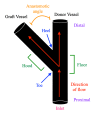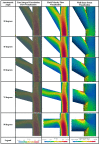Computational Fluid Dynamic Evaluation of Deep Inferior Epigastric Artery Perforator (DIEP) Flap End-to-Side Anastomosis
- PMID: 35663722
- PMCID: PMC9156394
- DOI: 10.7759/cureus.24650
Computational Fluid Dynamic Evaluation of Deep Inferior Epigastric Artery Perforator (DIEP) Flap End-to-Side Anastomosis
Abstract
Background End-to-side (ETS) microvascular anastomoses are utilized within deep inferior epigastric artery perforator (DIEP) flap breast reconstruction procedures. Optimization of these anastomoses via a computational fluid dynamic (CFD) model can minimize ischemia and contribute to flap success. Methods A CFD model of a deep inferior epigastric artery to internal mammary artery anastomosis was constructed with OpenFOAM software (OpenCFD Ltd., Bracknell, UK). Blood was modelled as an incompressible Newtonian fluid. Viscosity and density were assumed to be constant throughout the simulation. Mean arterial pressure was held constant at 100 mmHg. Individual virtual meshes were created for 30-, 45-, 60-, 75-, and 90-degree anastomotic angle simulations. Fluid flow was visualized with line integral convolution (LIC) and pure fluid velocity (PFV) techniques. Vessel wall shear stress (WSS) was also visualized. Results The LIC revealed blood recirculation was associated with large anastomotic angles with minimal to no recirculation seen in the 45- and 30-degree simulations. Any recirculation visualized was confined to the toe of the bifurcation. This recirculation was associated with stagnation in the toe of the graft vessel as well, as visualized by the PFV model. A linear relationship was identified between anastomotic angle and percentage of stagnant fluid, with stagnation increasing as the anastomotic angle increased. Wall shear stress increased with the anastomotic angle and was concentrated in the heel and toe of the model. Conclusions The CFD modelling shows that increased acuity of anastomotic angles in ETS DIEP flaps is essential to minimize stagnation, recirculation, and WSS. Successful implementation of this recommendation may directly decrease the risk of flap failure from ischemia.
Keywords: computational fluid dynamics; diep flap; end-to-side anastomosis; free flap; ischemia; simulation.
Copyright © 2022, Jinka et al.
Conflict of interest statement
The authors have declared financial relationships, which are detailed in the next section.
Figures




Similar articles
-
"Mini-Flow-Through" Deep Inferior Epigastric Perforator Flap for Breast Reconstruction with Preservation of Both Internal Mammary and Deep Inferior Epigastric Vessels.Arch Plast Surg. 2015 Nov;42(6):783-7. doi: 10.5999/aps.2015.42.6.783. Epub 2015 Nov 16. Arch Plast Surg. 2015. PMID: 26618128 Free PMC article.
-
Lower Extremity Reconstruction with Anterolateral Thigh Free-Flap Anastomoses: A Computational Fluid Dynamic Analysis.J Reconstr Microsurg. 2024 Jan;40(1):12-22. doi: 10.1055/a-2056-0629. Epub 2023 Mar 16. J Reconstr Microsurg. 2024. PMID: 36928905
-
Flow and wall shear stress in end-to-side and side-to-side anastomosis of venous coronary artery bypass grafts.Biomed Eng Online. 2007 Sep 26;6:35. doi: 10.1186/1475-925X-6-35. Biomed Eng Online. 2007. PMID: 17897460 Free PMC article.
-
A novel coronary artery bypass graft design of sequential anastomoses.Ann Biomed Eng. 2010 Oct;38(10):3135-50. doi: 10.1007/s10439-010-0068-5. Epub 2010 May 22. Ann Biomed Eng. 2010. PMID: 20496004 Review.
-
Dynamic InfraRed Thermography (DIRT) in DIEP-flap breast reconstruction: A review of the literature.Eur J Obstet Gynecol Reprod Biol. 2019 Nov;242:47-55. doi: 10.1016/j.ejogrb.2019.08.008. Epub 2019 Aug 23. Eur J Obstet Gynecol Reprod Biol. 2019. PMID: 31563818 Review.
Cited by
-
Analysis of Major and Minor Pedicles in Flap Perfusion by Computational Fluid Dynamics.Plast Reconstr Surg Glob Open. 2024 Apr 10;12(4):e5711. doi: 10.1097/GOX.0000000000005711. eCollection 2024 Apr. Plast Reconstr Surg Glob Open. 2024. PMID: 38600970 Free PMC article.
-
Predictors, management and prognosis of initial hyperemia of free flap.Sci Rep. 2024 Feb 16;14(1):3894. doi: 10.1038/s41598-024-53834-2. Sci Rep. 2024. PMID: 38366051 Free PMC article.
References
-
- 2020 plastic surgery statistics report. [ Jul; 2004 ];https://www.plasticsurgery.org/documents/News/Statistics/2020/plastic-su... 20202020. 2020
-
- Preserving the internal mammary artery: end-to-side microvascular arterial anastomosis for DIEP and SIEA flap breast reconstruction. Apostolides JG, Magarakis M, Rosson GD. Plast Reconstr Surg. 2011;128:225–232. - PubMed
-
- Left breast radiation therapy doubles heart disease risk compared to right breast radiation therapy in young women. [ Nov; 2021 ];https://www.jacc.org/doi/10.1016/j.jaccao.2021.07.008?_ga=2.57704170.179... J Am Coll Cardiol CardioOnc. 2021 3:381–392.
-
- Computational modeling of microarterial anastomoses with size discrepancy (small-to-large) Rickard RF, Meyer C, Hudson DA. J Surg Res. 2009;153:1–11. - PubMed
LinkOut - more resources
Full Text Sources
Research Materials
Miscellaneous
